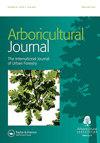On compression forks and axioms
Q3 Agricultural and Biological Sciences
引用次数: 1
Abstract
Dear Editor In Slater (2016), the “axiom of uniform stress” of Mattheck and Breloer (1994) is rightly questioned. And also in Drénou, Restrepo, and Slater (2020), a fine biomechanical approach to bark-included forks can be found, where they, rightly, question the “compression fork” model of Mattheck and Breloer (1994). However, simple reasoning and common sense might also shed light on this controversy, which has been subject of funded research, methodologies, scientific publications and the perhaps unfounded felling of many trees over the last three decades. According to the “axiom of uniform stress” (Mattheck & Breloer, 1994), a tree lays down extra wood where it is needed, for instance around a mechanical defect, to maintain a uniform stress level and to compensate for the biomechanical defect. However, another idea in the arboricultural scene, is the one that says that “crotches with included bark push each other apart as they grow in diameter”, which is the “compression fork” model, also by Mattheck and Breloer (1994). But . . ., if the branches were really pushed apart by “compression forks due to included bark”, would that stress then not be easily compensated by the tree by laying down extra wood (“axiom of uniform stress”), at the outer side of the fork and at the same time? There is something that is called “compensation wood”. Compensation wood is built where the tree experiences more stress or strain than biomechanically interesting for itself, and this being the result of experimented loads, structural inner defects, and so on. This process, even though not well understood yet, is called thigmomorphogenesis or the response by plants to mechanical sensations. Thus, and again, if thigmomorphogenesis really exists (which it does), would it not compensate for the “pushing apart” (if it really existed) of the branches at the height of the “compression fork”? And as the first (thigomorphogenesis) is a truth, the second (compression forks) could then be just a myth. Hence, accepting both the “axiom of uniform stress” and the “compression fork” model, both by the same authors, is impossible. The herein presented simple reasoning shows that the “compression fork” model by Mattheck and Breloer (1994) invalidates the same author’s “axiom of uniform stress”. If one accepts the first, the second can then only be rejected, and vice versa. Therefore, both their claims seem untenable.关于压缩叉和公理
在Slater(2016)中,matthecek和Breloer(1994)的“均匀应力公理”受到了正确的质疑。在drsamuou, Restrepo和Slater(2020)中,也可以找到一种很好的生物力学方法来研究包含树皮的叉子,他们正确地质疑了matthecek和Breloer(1994)的“压缩叉子”模型。然而,简单的推理和常识也可能揭示这一争议,这是过去三十年来资助研究、方法、科学出版物和可能毫无根据的砍伐许多树木的主题。根据“均匀应力公理”(Mattheck & Breloer, 1994),一棵树会在需要的地方,例如在机械缺陷周围,放置额外的木材,以保持均匀的应力水平,并补偿生物力学缺陷。然而,树木学领域的另一种观点认为,“包含树皮的树枝在直径增长时相互推开”,这是“压缩叉”模型,也是由matthececk和Breloer(1994)提出的。但是…,如果树枝真的被“由于包含树皮的压缩叉”分开,那么这种压力不会很容易地被树通过在叉的外侧和同时铺设额外的木材(“均匀应力公理”)来补偿吗?有一种东西叫做“补偿木”。补偿木材是在树木经历了比生物力学本身更大的压力或应变的情况下建造的,这是实验负荷、结构内部缺陷等的结果。这一过程虽然还没有被很好地理解,但被称为thigmomorphogenesis或植物对机械感觉的反应。因此,再一次,如果thigmomorphogenesis真的存在(它确实存在),它难道不会补偿“压缩叉”高度的分支“分开”(如果它真的存在)吗?由于第一个(thigomorphogenesis)是一个事实,第二个(压缩分叉)可能只是一个神话。因此,同时接受同一作者的“均匀应力公理”和“压缩叉”模型是不可能的。本文给出的简单推理表明,matthececk和Breloer(1994)的“压缩叉”模型否定了同一作者的“均匀应力公理”。如果一个人接受第一个,那么第二个就只能被拒绝,反之亦然。因此,他们的说法似乎都站不住脚。
本文章由计算机程序翻译,如有差异,请以英文原文为准。
求助全文
约1分钟内获得全文
求助全文
来源期刊

Arboricultural Journal
Agricultural and Biological Sciences-Agronomy and Crop Science
CiteScore
2.40
自引率
0.00%
发文量
28
期刊介绍:
The Arboricultural Journal is published and issued free to members* of the Arboricultural Association. It contains valuable technical, research and scientific information about all aspects of arboriculture.
 求助内容:
求助内容: 应助结果提醒方式:
应助结果提醒方式:


